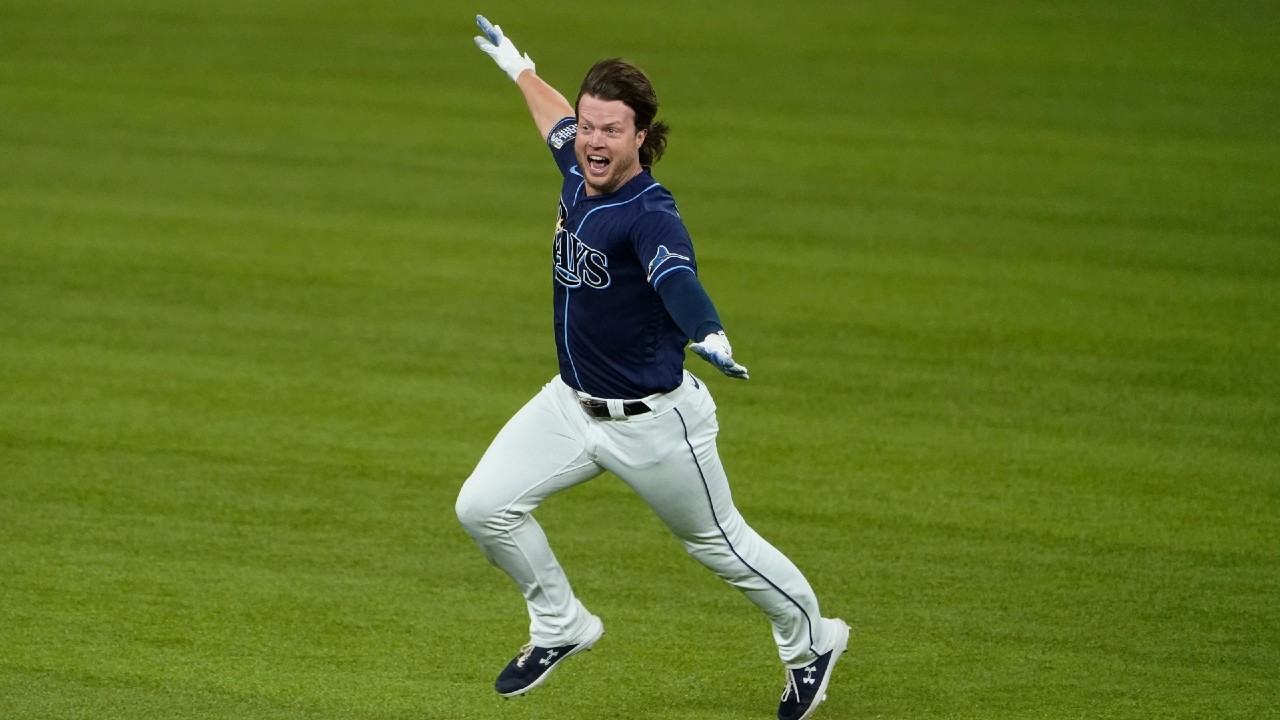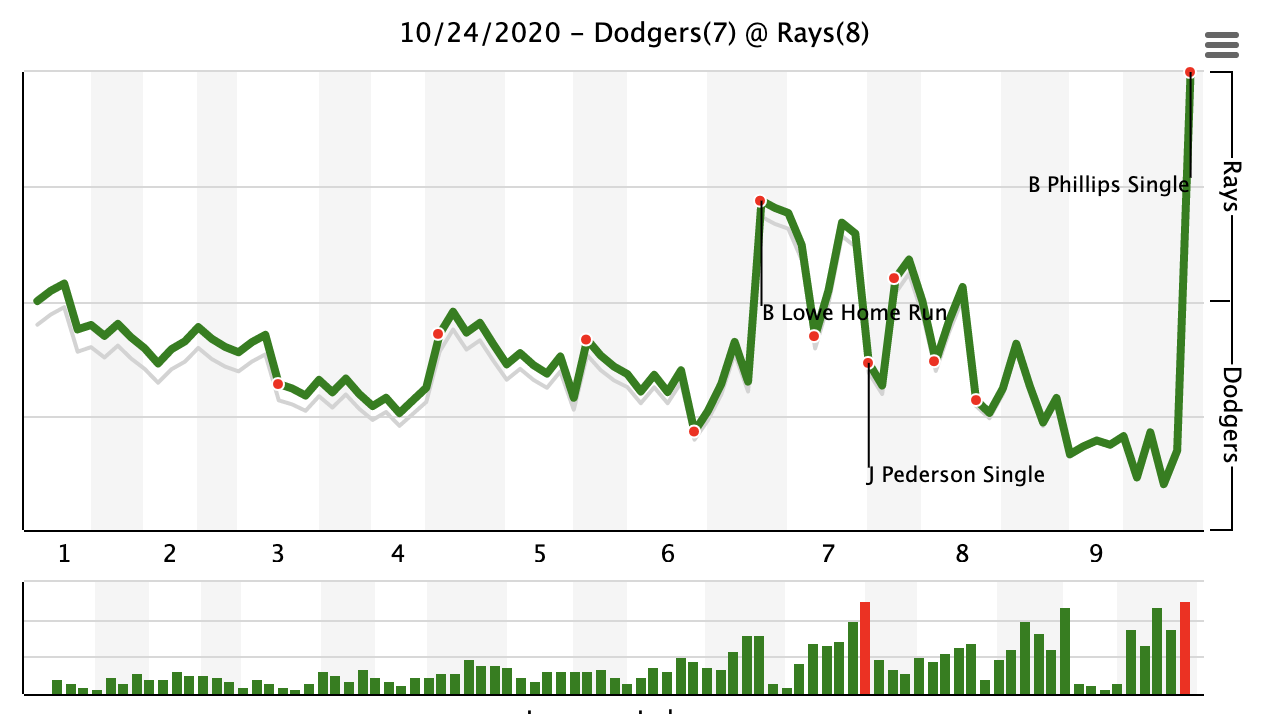
Down to their last out in Game 4 of the World Series, the Tampa Bay Rays sent Brett Phillips up to the plate to face Kenley Jansen. On paper it was a mismatch, even with two runners on base. But then again, nobody could have anticipated what happened next.
After falling behind in the count 1-2, Phillips lined a single to centre. Kevin Kiermaier scored easily to tie the game 7-7, and that should have been all the Rays got. But once centre fielder Chris Taylor bobbled the ball, a truly bizarre play unfolded in a matter of seconds.
Reading Taylor’s misplay, Randy Arozarena rounded third only to trip and fall halfway to home plate. The throw to the plate had Arozarena beat easily, but catcher Will Smith missed it, Arozarena scored and the Rays walked it off to tie the World Series at two games apiece. You had to see it to believe it.
Of all the frustrating playoff losses the Dodgers have suffered over the years, this one has to be up there. Those misplays cost Los Angeles a chance to hand Clayton Kershaw the ball with a 3-1 series lead in Game 5. Instead, Kershaw will face Tyler Glasnow with the series tied 2-2. In the meantime, here are some observations from a memorable Game 4…
How to make sense of a painful finish?
For an idea of just how painful this loss was for the Dodgers, take a look at the win probability graph for Game 4:

[ADD FG WS CHART]
Or simply watch Dave Roberts’ reaction to the last play of the game:
Give Phillips credit for a great at-bat against Jansen, but there’s no way the Dodgers should be losing a game like this. In this case the blame has to be shared between Jansen, who allowed two baserunners even before the Phillips single, Taylor, who should have fielded the ball cleanly, and Smith, who should have caught the relay throw.
If the Dodgers lose the series, it’s no exaggeration to say this loss will haunt them — possibly for a long time. So for Roberts, Kershaw and the Dodgers, the only possible outcomes are at the extremes now: either they lose a series they should have won or they win the franchise’s first title in more than three decades.
Seager’s flare nudges Dodgers ahead
On a night six different players homered, it was a flare into shallow centre field that finally allowed the Dodgers to take a late lead against the Rays. In the top of the eighth inning with two out and Taylor on second base, Nick Anderson pounded Corey Seager in on the hands with a 95.3 m.p.h. fastball.
Seager didn’t get much of it, but the blooper he hit had just enough on it to escape the grasp of shortstop Willy Adames and land in shallow centre field. With that, Seager had his fourth hit of the game and a .500 batting average for the series.
Questionable bullpen costs Rays
Maybe this was inevitable at some point. Or maybe it was simply a poorly timed off-night for the Tampa Bay bullpen. But it’s pretty surprising to see the Rays’ bullpen struggle like this.
Pitching in relief of starter Ryan Yarbrough Saturday, Pete Fairbanks, Diego Castillo and Anderson all allowed earned runs. We’re simply not used to seeing that kind of vulnerability from the Tampa Bay bullpen, and this time it nearly cost the Rays in a big way.
Thankfully the Rays’ offence bailed them out with runs in five of the last six innings, but Fairbanks, Castillo and Anderson would all be working on zero days’ rest if needed Sunday. It’s doable, and likely necessary, just not ideal.
Highs and Lowes
In the 14 playoff games leading up to the World Series, Brandon Lowe hit .115/.193/.173. It was an unexpected and ill-timed slump for a player who posted a .916 OPS during the regular season, but despite Lowe’s struggles the Rays kept winning.
If Kevin Cash and the Rays were ever tempted to bench Lowe, they never gave in to that temptation and they’ve since been rewarded. The 26-year-old hit two homers in Game 2 of the World Series, and on Saturday night when he stepped up with one out and two on in the bottom of the sixth inning, he did this:
That three-run shot was the biggest of Lowe’s career and one of the biggest in Rays franchise history.
But in the top of the seventh, the Dodgers loaded the bases with two out. Joc Pederson stepped in and lined a ball off the end of Lowe’s glove for a two-run single that gave the Dodgers the lead again.
Arozarena makes home run history
Entering play Saturday, four players in big-league history had ever hit eight home runs in the course of a single post-season:
• Barry Bonds (2002)
• Carlos Beltran (2004)
• Nelson Cruz (2011)
• Randy Arozarena (2020)
In the third inning, Seager joined that exclusive group with his eighth home run of the 2020 playoffs. And the very next inning, Arozarena separated himself from Seager & Co. with his ninth homer of the post-season.
To be fair, the wild-card round gave Arozarena and Seager a couple more games than usual, but their accomplishments are impressive nonetheless.
Urias flashes overpowering stuff
The first time Julio Urias appeared on Baseball America’s list of top 100 prospects was after the 2013 season. At the time, he was just 17, but his promise was apparent even when the Dodgers signed him out of Mexico as a teenager.
Seven years and parts of five big-league seasons later, Urias is now enjoying a breakout season. The 24-year-old pitched well in the regular season, with a 3.27 ERA in 55 innings, and has been even more effective in the playoffs.
That trend continued in Game 4, as Urias overpowered the Rays for 4.2 innings. His fastball topped out at 96.1 m.p.h. and may have looked even faster considering the Rays whiffed 17 times at that pitch on the way to nine strikeouts for Urias.
In five appearances this post-season, he now has a 1.31 ERA with 25 strikeouts compared to just four walks. Safe to say that prospect pedigree has been realized considering he’s now one of the most important pitchers on one of baseball’s best teams.




